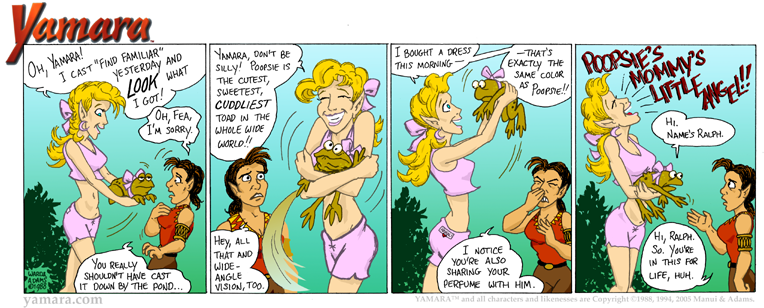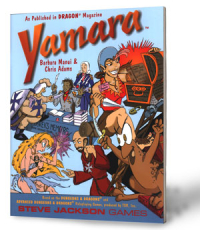Poopsie Generation
First published: January, 1989. First posted online: June 16, 2005.
See this episode in the original b&w.
Submitted for your consideration: The scene, a quiet glade outside an everyday fantasy hamlet. The players, two denizens of this land, destined here to meet. And the motivation, a sorcery designed to summon a familiar, for the first time, to its mage.
But the dweamor is imperfect. The chances, one in ten, that instead of a blissful state of magical communion, the most undesirable of companionships would begin. That instead of bonding with a spirit of arcane wisdom, one would look into a ghastly mirror, ever unable to pull away, as one’s inner shames are revealed in flesh, allowing the world to jape and stare.
Such is the cruel fate of gentle Ralph, age 12, who attained an unexpected disappointment, by answering the call…
of the Twilight Zone.
FAQ
Q. How do you two create together?
A. As we state in the book:
…it’s not a simple division with us; we both write the strip, and although it’s Chris’ hand that draws the finals, we usually write in tandem, with a clipboard between us, laying ut the panels at the same time we write the dialogue. …We’ve heard it’s not standard comic writing technique, but it’s the only method that makes sense to us, since often an image will prove a natural shortcut, eliminating a whole lot of verbiage.
There are degrees in which each of us write better than the other. Chris is pretty good with seeing how stories progress and arc, feeling it out from many episodes away– a skill more useful in dramatic works and while GMing. Bar has an ability to see depth and angles in any character, and can rattle off the complexities of a previously-uncreated imaginary person, in one sitting, off the top of her head.
She also has demonstrated the uncanny ability to find the critical element of any scene. It doesn’t happen every time, but when she does it, it hits like a laser-guided missile.
Case in point, this episode. As we stated in Radio Free Wyhtl 0.2 (correcting an assertion from the book) Fea was loosely based on a grey elf character (“Fea-Tathin”) Chris created and played briefly in someone else’s campaign. Fea-Tathin had cast Find Familiar, and got a toad.
Some explanation for those who aren’t big D&Ders: mages, at least in first edition AD&D, could cast this spell, and randomly receive an animal companion. An owl, a cat, or a weasel were possibilities, and there was a slim chance of getting a really cool one, like a little dragon or even a pocket-sized demon (if you’re a bad girl). There was a 20% chance of getting nothing, and you’d have to wait a year to try again. But even the common critters were useful, since they could fly or spy around for you, and could lend you their hit points.
But there was a 10% chance of getting a toad. Yeah, ugly and useless. You couldn’t send it away, because you’d have to wait till it died before you could summon another, and killing it was out, because damage to it was damage to yourself, and everyone would hate you afterwards or something. Getting the toad was simply worse than getting nothing.
Of course, Chris’ player character Fea-Tathin had hated her toad. Just despised it. It was what was expected. Any player would.
So when we were trying to come up with typical AD&D parodies, the toad-hating seemed a natural. But Chris was stuck. Fea wasn’t evil (yet), and loading an animal into a catapult seemed uninspired and anti-SPCA. The situation was already rife with humorous humiliation– nearly every gaming group in the country had experienced it– but the spin wasn’t obvious. How to joke about hating a toad?
Chris had gone outside, to struggle over the empty page. Fea was his character once, after all, he’d figure it out. Over an hour later, Bar found him squatting on a wall, still totally blocked on toad-hating.
“What if she likes the toad?” she suggested.
The rest, is history.



Toad Familiars–the First Edition “fixer-upper”..
And in 3.0, the one every savvy wizard chooses.